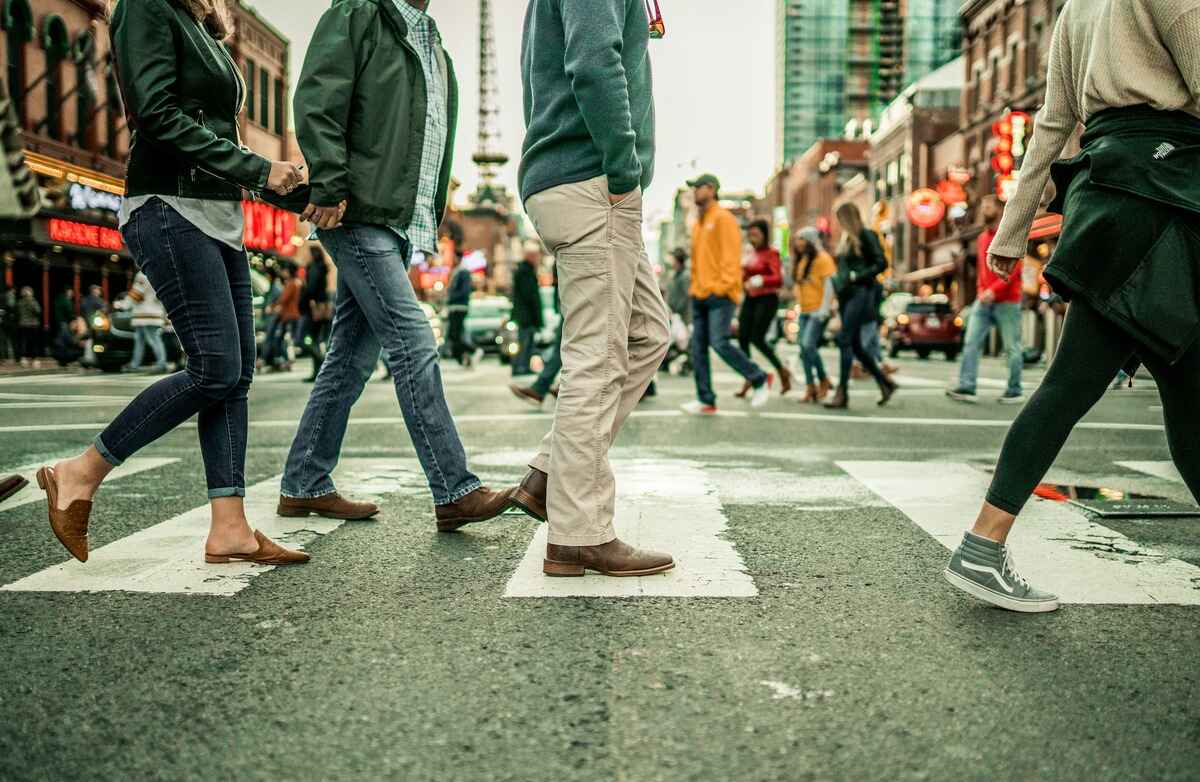Home>Language and Grammar>Understanding The Meaning Of “Ped Xing” And Its Significance


Language and Grammar
Understanding The Meaning Of “Ped Xing” And Its Significance
Published: February 12, 2024
Discover the significance of "Ped Xing" and its meaning in language and grammar. Uncover the linguistic and cultural relevance of this commonly seen sign.
(Many of the links in this article redirect to a specific reviewed product. Your purchase of these products through affiliate links helps to generate commission for Noodls.com, at no extra cost. Learn more)
Table of Contents
Introduction
Have you ever noticed the peculiar phrase "Ped Xing" on road signs and wondered what it means? "Ped Xing" is not a mysterious code or a secret language; it's a simple abbreviation for "pedestrian crossing." These signs are strategically placed at designated points along roadways to alert drivers to the presence of pedestrian crossings. Understanding the significance of "Ped Xing" signs is crucial for promoting road safety and fostering a harmonious coexistence between pedestrians and motorists.
The term "Ped Xing" may initially appear cryptic or enigmatic, but it holds a straightforward meaning that directly impacts the safety of pedestrians and the smooth flow of traffic. By delving into the origin, purpose, and importance of "Ped Xing" signs, we can gain a deeper appreciation for their role in enhancing road safety and facilitating the seamless movement of both pedestrians and vehicles. Let's embark on a journey to unravel the meaning and significance of "Ped Xing" signs, shedding light on their vital role in our daily lives.
The Origin of "Ped Xing"
The enigmatic abbreviation "Ped Xing" has sparked curiosity and intrigue among many individuals. However, its origins can be traced back to a practical and functional source. The term "Ped Xing" is a shortened form of "pedestrian crossing," which is commonly used in road signage across the United States.
The abbreviation "Ped Xing" is a product of the English language's penchant for condensing words and phrases to create concise and easily recognizable symbols. This linguistic trend aligns with the need for clear and unambiguous signage on roadways, where space and visibility are at a premium. By compressing "pedestrian crossing" into "Ped Xing," road authorities can convey the essential message effectively while conserving space on signs.
The use of abbreviations in road signage is not unique to "Ped Xing." In fact, it reflects a broader practice of condensing lengthy phrases into succinct symbols or acronyms to convey vital information to drivers and pedestrians. This approach streamlines communication and ensures that signage remains clear and comprehensible, even at a glance.
The adoption of "Ped Xing" as a standard abbreviation for pedestrian crossings reflects a deliberate effort to streamline and standardize road signage across the country. By employing a consistent abbreviation, road authorities can promote uniformity and clarity in signage, reducing the likelihood of confusion or misinterpretation among road users.
In essence, the origin of "Ped Xing" can be attributed to the need for efficient and effective communication on roadways. This abbreviation exemplifies the ingenuity of language and the practical considerations that underpin the design of road signage. By understanding the origins of "Ped Xing," we can appreciate its role as a concise yet impactful symbol that conveys the crucial message of pedestrian crossings to motorists, contributing to the overall safety and functionality of our roadways.
The Purpose of "Ped Xing" Signs
The purpose of "Ped Xing" signs extends far beyond their role as mere visual elements on roadways. These signs serve as vital markers that delineate designated pedestrian crossings, playing a pivotal role in promoting safety and facilitating the smooth interaction between pedestrians and motorists.
At their core, "Ped Xing" signs are designed to alert drivers to the presence of pedestrian crossings, signaling the need for heightened vigilance and caution. By prominently displaying these signs at strategic points along roadways, authorities aim to enhance awareness among motorists, prompting them to anticipate and yield to pedestrians at these designated crossings. This proactive approach is instrumental in mitigating the risk of accidents and fostering a safer environment for pedestrians to traverse roadways.
Moreover, "Ped Xing" signs serve as visual cues that guide pedestrians to safe crossing points, delineating areas where they can navigate roadways with an added layer of protection. By clearly demarcating these crossings, the signs empower pedestrians to assert their right of way and navigate intersections with a heightened sense of security. This not only bolsters pedestrian safety but also contributes to the efficient flow of foot traffic, particularly in urban areas where pedestrian crossings are integral to mobility and accessibility.
In addition to their functional role in delineating pedestrian crossings, "Ped Xing" signs also convey a broader message of inclusivity and respect for pedestrian rights. By prominently featuring these signs, road authorities underscore the importance of accommodating and prioritizing the needs of pedestrians within the larger framework of transportation infrastructure. This emphasis on pedestrian safety and accessibility aligns with the overarching goal of creating roadways that cater to diverse modes of transportation, fostering a more equitable and harmonious coexistence between pedestrians and motorists.
Furthermore, the presence of "Ped Xing" signs communicates a clear directive to motorists, signaling the legal obligation to yield to pedestrians at designated crossings. This not only reinforces the legal framework that governs pedestrian right of way but also instills a sense of accountability among drivers, underscoring the shared responsibility for upholding pedestrian safety on roadways.
In essence, the purpose of "Ped Xing" signs transcends their visual representation, encompassing a multifaceted role in promoting safety, guiding pedestrian movement, and reinforcing the principles of inclusivity and mutual respect on roadways. These signs stand as tangible symbols of the concerted efforts to prioritize pedestrian safety and integrate their needs into the broader landscape of transportation infrastructure, ultimately contributing to a more secure and cohesive urban environment.
The Importance of "Ped Xing" in Road Safety
The significance of "Ped Xing" signs in road safety cannot be overstated, as they play a pivotal role in safeguarding the well-being of pedestrians and fostering a secure environment for all road users. These distinctive signs serve as a linchpin in the intricate framework of road safety measures, contributing to the prevention of accidents and the seamless coexistence of pedestrians and motorists.
At its core, the importance of "Ped Xing" in road safety lies in its ability to heighten awareness and vigilance among motorists. By prominently featuring these signs at designated pedestrian crossings, road authorities effectively communicate the imperative for drivers to exercise caution and yield to pedestrians. This proactive signaling serves as a potent deterrent against potential collisions, as it prompts drivers to adjust their speed and behavior, thereby reducing the risk of accidents at these critical junctures.
Moreover, "Ped Xing" signs act as visual beacons that guide pedestrians to safe crossing points, empowering them to navigate roadways with a heightened sense of security. These signs delineate areas where pedestrians can assert their right of way, fostering a conducive environment for safe and unimpeded pedestrian movement. In doing so, "Ped Xing" signs not only bolster pedestrian safety but also contribute to the efficient flow of foot traffic, particularly in bustling urban settings where pedestrian crossings are integral to mobility and accessibility.
Furthermore, the presence of "Ped Xing" signs underscores the legal and ethical obligation for motorists to yield to pedestrians at designated crossings. This emphasis on pedestrian right of way not only reinforces the legal framework governing road safety but also instills a culture of mutual respect and accountability among road users. By upholding the sanctity of pedestrian crossings, "Ped Xing" signs engender a climate of shared responsibility, wherein drivers and pedestrians coalesce in upholding the principles of safety and courtesy on roadways.
In essence, the importance of "Ped Xing" in road safety transcends its visual representation, embodying a multifaceted role in promoting awareness, guiding pedestrian movement, and fostering a culture of mutual respect and accountability among road users. These signs stand as tangible symbols of the collective commitment to prioritize pedestrian safety and integrate their needs into the broader fabric of transportation infrastructure, ultimately contributing to a more secure and cohesive urban environment.
Common Misconceptions about "Ped Xing"
Despite its widespread familiarity, the term "Ped Xing" has inadvertently given rise to several misconceptions and misunderstandings among the public. These misconceptions often stem from a lack of clarity regarding the purpose and significance of "Ped Xing" signs, leading to erroneous assumptions and interpretations. By addressing these common misconceptions, we can dispel confusion and foster a more informed understanding of the role played by "Ped Xing" in promoting road safety and pedestrian well-being.
-
Misconception: Unfamiliarity with the Abbreviation
One prevalent misconception revolves around the unfamiliarity with the abbreviation "Ped Xing." Some individuals may perceive it as an obscure or cryptic code, leading to confusion about its meaning. This lack of familiarity can inadvertently diminish the effectiveness of "Ped Xing" signs in conveying their intended message to road users. By demystifying the abbreviation and elucidating its connection to "pedestrian crossing," we can enhance public awareness and ensure that the signs fulfill their crucial role in alerting drivers to pedestrian crossings. -
Misconception: Perceived Insignificance
Another common misconception pertains to the perceived insignificance of "Ped Xing" signs. Some individuals may overlook or underestimate the importance of these signs, viewing them as mere visual elements without substantial relevance. This misconception undermines the pivotal role played by "Ped Xing" signs in promoting pedestrian safety and delineating designated crossing points. By dispelling this misconception, we can underscore the indispensable nature of these signs in fostering a secure environment for pedestrians and motorists alike. -
Misconception: Misinterpretation as a Location or Destination
A notable misconception surrounding "Ped Xing" involves its misinterpretation as a specific location or destination rather than a designation for pedestrian crossings. This misunderstanding may lead to confusion among road users, potentially impacting their adherence to traffic regulations and pedestrian right of way. By clarifying the true meaning of "Ped Xing" as an abbreviation for "pedestrian crossing," we can avert misinterpretations and ensure that road users recognize and respect the significance of these designated crossing points. -
Misconception: Lack of Awareness of Pedestrian Right of Way
Additionally, a prevalent misconception revolves around a lack of awareness regarding pedestrian right of way at "Ped Xing" locations. Some individuals may overlook the legal and ethical obligation for motorists to yield to pedestrians at these designated crossings, leading to potential conflicts and safety hazards. By addressing this misconception and reinforcing the principles of pedestrian right of way, we can cultivate a culture of mutual respect and accountability among road users, thereby enhancing safety at pedestrian crossings.
In essence, by dispelling these common misconceptions about "Ped Xing," we can foster a more informed and conscientious approach to road safety and pedestrian interactions. Through enhanced awareness and clarity, we can underscore the vital role played by "Ped Xing" signs in promoting pedestrian well-being and harmonizing the coexistence of pedestrians and motorists on roadways.
Conclusion
In conclusion, the enigmatic abbreviation "Ped Xing" encapsulates a rich tapestry of significance and purpose within the realm of road safety and pedestrian mobility. Despite its seemingly cryptic appearance, "Ped Xing" serves as a succinct yet potent symbol that conveys the essential message of pedestrian crossings to motorists, fostering a climate of heightened awareness and vigilance on roadways.
The origin of "Ped Xing" reflects the pragmatic need for efficient communication on road signage, exemplifying the ingenuity of language and the practical considerations that underpin the design of transportation infrastructure. By condensing "pedestrian crossing" into "Ped Xing," road authorities have established a standardized and recognizable abbreviation that transcends linguistic barriers, serving as a universal beacon for pedestrian safety.
The purpose of "Ped Xing" signs extends beyond their visual representation, encompassing a multifaceted role in promoting safety, guiding pedestrian movement, and reinforcing the principles of inclusivity and mutual respect on roadways. These signs stand as tangible symbols of the concerted efforts to prioritize pedestrian safety and integrate their needs into the broader framework of transportation infrastructure, ultimately contributing to a more secure and cohesive urban environment.
The importance of "Ped Xing" in road safety cannot be overstated, as these signs play a pivotal role in safeguarding the well-being of pedestrians and fostering a secure environment for all road users. By heightening awareness and vigilance among motorists, guiding pedestrian movement, and reinforcing a culture of mutual respect and accountability, "Ped Xing" signs serve as linchpins in the intricate framework of road safety measures, contributing to the prevention of accidents and the seamless coexistence of pedestrians and motorists.
Furthermore, by dispelling common misconceptions surrounding "Ped Xing," we can foster a more informed and conscientious approach to road safety and pedestrian interactions. Through enhanced awareness and clarity, we can underscore the vital role played by "Ped Xing" signs in promoting pedestrian well-being and harmonizing the coexistence of pedestrians and motorists on roadways.
In essence, "Ped Xing" transcends its status as a mere abbreviation; it embodies a collective commitment to prioritize pedestrian safety and integrate their needs into the broader fabric of transportation infrastructure. As we navigate the bustling thoroughfares of our cities and towns, let us heed the silent yet resounding call of "Ped Xing," embracing its message as a beacon of safety, inclusivity, and mutual respect in our shared journey on the roadways.














